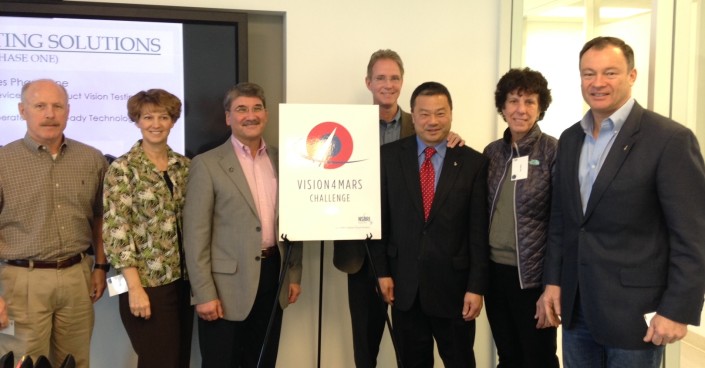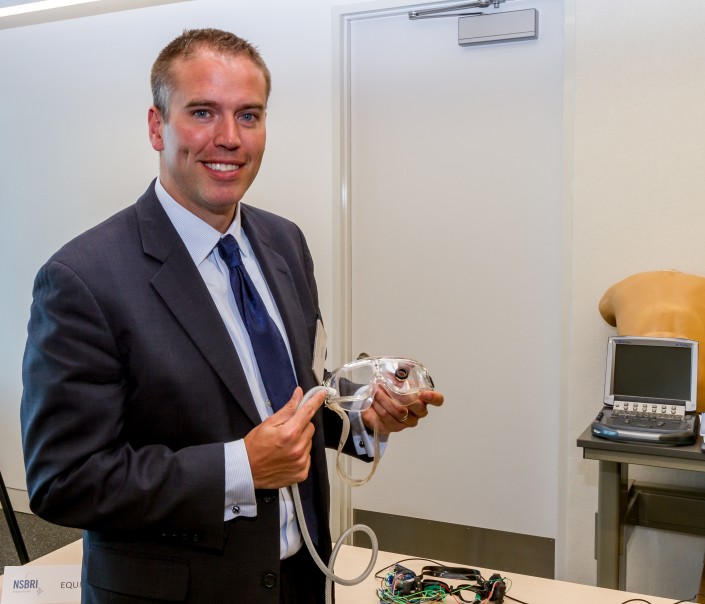2015
eVision Smart Optics, Inc.

Commander Leroy Chiao, ret., tries on a pair of glasses with electronically adjustable lenses developed by eVision Smart Optics.
eVision Smart Optics specializes in the development of electronic lenses based upon liquid crystal technology for both eyeglasses and lens-based equipment. Many astronauts experience vision changes during spaceflight that impact their visual acuity. Eyeglasses that can be adjusted in real-time to accommodate an astronaut’s changing vision would eliminate the need to carry multiple sets of glasses into space. eVision has already developed eyeglasses for age-related presbyopia that enable the wearer to use an on-frame switch to change the lens power from a standard prescription to a reading prescription. The company has partnered with Mitsui Chemical on this product and it will be introduced by Mitsui in 2016. eVision will use the SMARTCAP grant to develop, fabricate & deliver remotely adjustable, electronic power eyeglasses with a single variable power optical zone.

Commander Ken Bowersox, ret., examines the lens material for eVision Smart Optics’ electronically tunable lenses, while Tony Van Heugten, eVision’s Chief Technology Officer, explains the liquid crystal technology.
LumosTech, Inc

Commander Ken Bowersox, ret., and Dr. Jon Clark of NSBRI learn about LumosTech’s smart sleep mask from Dr. Biquan Luo, COO, and Vanessa Burns, CEO, of LumosTech.
LumosTech has developed a programmable sleep mask that uses millisecond pulses of light, administered while the wearer is sleeping, to shift circadian rhythm via the same neural pathways as natural light. Astronauts on the International Space Station (ISS) operate on the basis of a 24 hour day for their work schedule but can experience 16 sunrises in a 24 hour period. Maintaining a normal sleep schedule and being ready for mission critical tasks can be quite challenging. The LumosTech programmable sleep mask can be individually tailored to meet the requirements of each astronaut, helping ensure that they are well-rested and at peak performance when necessary. Building on decades of light therapy research proving that continuous light can shift circadian rhythm, the researchers at Stanford University discovered and validated that short pulses of light (2ms) administered every 45 seconds for one hour during the night can adjust the sleep cycle at double the rate of continuous light while not interfering with normal sleep. This technology holds promise for jet-lagged travelers, shift workers and exhausted new parents in addition to astronauts and NASA ground crew.
Equinox, LLC
With support from NSBRI’s Space Medical and Related Technologies Commercialization Program (SMARTCAP) Equinox, LLC will develop Balance Goggles™, a simple and comfortable pair of eyewear that will help regulate the pressure inside the eye. Equinox proposes to gently push on the exterior of the eye to stabilize the internal pressure within the eye by building mild pressure-regulating goggles.
The goggles will need to be worn for a specific amount of time in order to alleviate the pressure differential that may be causing the visual problems observed in some astronauts. This technology also has the potential to benefit millions of glaucoma patients around the world who do not respond to, or cannot take, currently approved medications. By using these goggles to decrease the pressure within the eye, patients may avoid surgery or the side effects of medication.
Annidis Corporation

Mr. Nick Ribaric and Mr. Richard Clayton from Annidis Corporation demonstrate their multispectral imaging device
Annidis Corporation’s Annidis RHA™ is a multispectral ophthalmoscope with multi-image software processing that quickly and non-invasively images the retina with such fine detail as to rival invasive and more complicated procedures. “Annidis’ Multi-Spectral Imaging is a revolutionary technology for early detection of outer retinal and choroidal disorders, which can potentially affect astronauts during long duration space travel. This device is complementary to the diagnostic capabilities that are already on board the International Space Station as it creates a series of discrete ‘spectral images’ throughout the entire thickness of the retina and choroid,” said Dr. Gene de Juan, the Jean Kelly Stock Distinguished Professor of Ophthalmology at University of California, San Francisco, and a member of the Vision for Mars Advisory Team.
Web Vision Centers Group

NSBRI User Panel members meet with Mr. Bob Main from Web Vision Center Groups to advise on variable prescription glasses for spaceflight (L to R, Commander Ken Bowersox (NASA astronaut, ret.), Commander Eileen Collins (NASA astronaut, ret.), Mr. Bob Main, Dr. Bob Gibson (NASA optometrist), Commander Leroy Chiao (NASA astronaut, ret.), Dr. Ellen Baker (NASA astronaut, ret.), and Michael Lopez-Alegria (NASA astronaut, ret.)
Web Vision Centers Group intends to offer prescription adjustable glasses. One possibility is electronic glasses. Astronauts will be able to plug their glasses into a computer that will allow them to change the prisms in the lenses, which will alter the prescription. The other option available today is magnetic lenses, which enables wearers to switch out lenses, required by different prescriptions, on an as-needed basis.
The Earth-based markets for these lenses includes eye surgery patients whose prescriptions change over time, diabetic patients who have the need for variable prescriptions, and children who require new glasses as their eyes and vision change.







